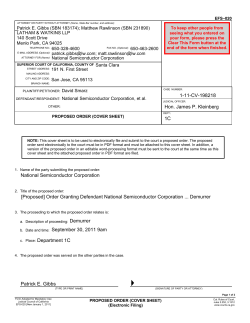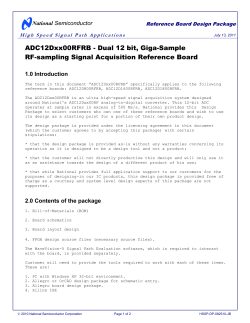
ACOUSTELECTRIC METHOD FOR INVESTIGATION OF
Molecular and Quantum Acoustics vol. 28 (2007) 223 ACOUSTELECTRIC METHOD FOR INVESTIGATION OF ELECTRICAL CARRIER MOBILITY OF REAL GAP:TE (110) SURFACE Tadeusz PUSTELNY and Barbara PUSTELNY Institut of Physics, Silesian University of Technology ul.Krzywoustego 2, 44-100 Gliwice, POLAND The acoustic method of investigating the carrier mobility in the near-surface region of a semiconductor is presented. In this method the transverse acoustoelectric voltage versus the absorbed surface acoustic wave power was measured to determine nondestructively the carrier mobilites. In the layered structure: piezoelectric - semiconductor, the majority and minority carrier mobilities can be determined basing on the field effect. Single GaP:Te(110) crystals have been investigated after various kinds pf surface treatment. The carrier mobility values range from 75 to 120 [cm2/ V s]. The results determined by means of the TAV method are in satisfactory agreement with the results obtained by Hall measurements. 1. EXPERIMENTAL During the past years, the high-frequency and nondestructive surface acoustic wave (SAW) measurement technique has been developed and used to characterise the electron and electrical surface properties of semiconductor materials. A surface acoustic wave in piezoelectric materials is accompanied by a decaying electric field which interacts with the free carriers of the semiconductor placed nearby. The reaches of effects which are results of this interaction is really great [1,2]. In the majority of these experiments, transverse acoustoelectric voltage (TAV) methods were used [3]. By the TAV methods can be determined such important surface semiconductor parameters as: the carrier density [4], the type of electrical conductivity near the surface region, the electrical surface potential [5], the lifetime of minority carriers [6], excess generation and recombination lifetime, deep-levels in bend gap and their activation energy [3]. 224 Pustelny T., Pustelny B. Carrier mobility is one the first semiconductor parameters that was measured using a surface acoustic wave [7,8]. It was determined in the acoustoelectric amplifier structure, but the measurement was difficult and dangerous because it requierd the the application high voltage in semiconductor samples. In this paper we present the results of carrier mobility investigations in GaP:Te by means of the transverse acoustoelectric voltage method. The physical base of this method was presented in [9]. In [9,10] the amplitude UAE of transverse acoustoelectric voltage in a semiconductor is described by: U AE = αPav µ εεoωV s (1) and 1 P 02 α= ln ; 2L P 01 UAE = αPav µ εεoωVs Pabs = b[1 − exp(2αL)] Pav where: (2-4) µ - mobility of charge carriers, UAE - amplitude of acoustoelectric voltage, P02, P01 - output SAW powers with and without a semiconductor, respectively, VS, ω - surface acoustic wave velocity and frequency, respectively, b, L - width and length of the semiconductor sample, respectively Pabs - absorbed SAW power Pav - average SAW power per unit width εεo - semiconductor permittivity From UAE it can be seen that the mobility of the majority carrier can be determined by measurements of the slope of the TAV versus the absorbed SAW power. The transverse acoustoelectric voltage method was used to study single crystal GaP:Te(110) samples with the following volumetric parameters, determined by their producer (prof. J. Bobitskiy from the Technical University in Lviev, Ukraine): – n-type electrical conductivity – carriers mobility: µn =125 [cm2/V*s], µp =75 [cm2/V*s] – permittivity: ε = 8.3 Molecular and Quantum Acoustics vol. 28 (2007) – band gap : Eg = 2.2 eV – electron concentration: Nd =1 *1021 [m-3] – effective mass of holes and electrons mp*= 0.12 and mn,* = 0.50 225 The applied experimental set-up TAV versus the absorbed SAW power was presented in [11]. A high frequency (50-300 MHz) of about 2 µs pulse duration was applied in the input transducer to generate a surface acoustic wave (SAW) on Y-cut, Z- propagating in LiNbO3 delay line. The semiconductor sample is paced on the surface of the delay line by two isolating distance bars in order to assure a non acoustic contact between the semiconductor and the piezoelectric wave guide. The dimensions of the samples were: 7x8x0.6 mm. The transverse acoustic signal across the semiconductor is detected by placing an Al plate on the back surface of the semiconductor and another one under the semiconductor sample placed on the acoustic wave guide. To get the best contact between the investigated semiconductor surface and the TAV electrode, on the wave guide this electrode was produced as a strip [11]. The electrical properties of the semiconductor surface in the near-surface region can be changed by applying the external, perpendicular electric voltage Ud across the semiconductor sample. This is easy and convenient means of the changes of surface electric properties. It was applied early by us in various semiconductor surface investigations, among other in: electrical potential and carrier concentration in semiconductor near-surface region[3,4,12]. In Fig.1, the UAE amplitude versus Pav for our GaP:Te crystal are presented. In these measurements, the field effect (Ud) was used to vary the effective mobility of the semiconductor surface carrier. 226 Pustelny T., Pustelny B. Fig. 1 The UAE amplitude versus Pav in the case of various GaP surface treatments. Fig. 2 The amplitude UAE=f(Pav) after various surface treatments (Ud=0): a) alumina powder grinding, b) diamond paste polishing, c) etching in HNO3 acid, d) etching in HF acid. For the investigated GaP:Te (110) surface, the values of the carrier mobility obtained by means of the method presented above were equal to (for Ud = 0): – for a) µ = 75 ± 10 [cm2/Vs] (after alumina powder grinding); – for b) µ = 120 ± 10 [cm2/Vs] (after diamond paste polishing); – for c) µ = 90 ± 10 [cm2/Vs] (after HNO3 acid etching); – for d) µ = 95 ± 10 [cm2/Vs] (after HF acid etching). Molecular and Quantum Acoustics vol. 28 (2007) 227 2. CONCLUSION From the presented results it follows that this acoustoelectric method may be a useful tool in the study of surface semiconductors. The samples, investigated by means of the TAV method display a high resistivity and the n-type electrical conductivity. After applying surface treatments, the value of their carrier mobility changes considerably, even by some tens percent. It is very important that the TAV method does not require ohmic contacts with the semiconductor sample. Thus, the surface carrier mobility is not changed by the difficult technology of the ohmic contact process. This is the high-frequency method, and it is essential that this method provides dynamic values of the carrier mobility. ACKNOWLEDGEMENT The work has been co-sponsored within the research grant MNiSW No. R01 03901. REFERENCES 1. R. Adler, IEEE SU, 10, (1988), 139-144. 2. Yu. Gulayev, Proc. of Summer Scool on Acoustic, Sicily, 94-140 (1989). 3. M.Tabib-Azar, P. Das,at all, J. Vac.Sci. Technol. B 9 (1), 95-110 (1991). 4. T. Pustelny, J. Tech. Phys. 19/1, 49-62 (1995). 5. T. Pustelny, Z.Kubik,, Arch. Acoustics 19/2, 119-124 (1994). 6. B. Adamowicz, T. Pustelny, J. Tech. Phys. 34/3, 299-309 (1993). 7. T. Pustelny, Ultrasonics 33/4, 289-294 (1995 ). 8. A. Opilski T. Pustelny, Arch. Acoustics 10/2, 143-150 (1985). 9. T. Pustelny, Acta Physica Polonica A 88/6, 1123-1132 (1995). 10. M. Tabib-Azar, PhD Thesis, RPI, 1986. 11. P. Das, M. Tabib-Azar, Appl. Phys. A 45, 119-124 (1988). 12. T. Pustelny, Arch. Acoustics 22/1, 24-36 (1995). 13. T. Pustelny, ACUSTICA-Acta Acustica 83, 482-488 (1997). 14. T. Pustelny, B. Pustelny, Molecular and Quantum Acoustics 27, 213-226 (2006).
© Copyright 2025









